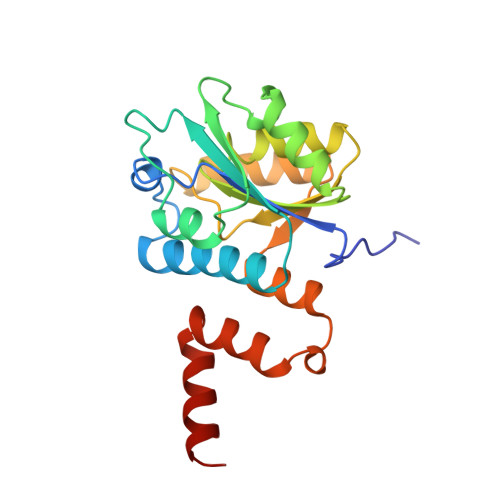The 1.8 A crystal structure of the ycaC gene product from Escherichia coli reveals an octameric hydrolase of unknown specificity.
Colovos, C., Cascio, D., Yeates, T.O.(1998) Structure 6: 1329-1337
- PubMed: 9782055
- DOI: https://doi.org/10.1016/s0969-2126(98)00132-4
- Primary Citation of Related Structures:
1YAC - PubMed Abstract:
The ycaC gene comprises a 621 base pair open reading frame in Escherichia coli. The ycaC gene product (ycaCgp) is uncharacterized and has no assigned function. The closest sequence homologs with an assigned function belong to a family of bacterial hydrolases that catalyze isochorismatase-like reactions, but these have only low sequence similarity to ycaCgp (approximately 20% amino acid identity). The ycaCgp was obtained and identified during crystallization trials of an unrelated E. coli protein with which it co-purified. The 1.8 A crystal structure of ycaCgp reveals an octameric complex comprised of two tetrameric rings. A large three-layer (alphabetaalpha) sandwich domain and a small helical domain form the folded structure of the monomeric unit. Comparisons with sequence and structure databases suggest that ycaCgp belongs to a diverse family of bacterial hydrolases. The most closely related three-dimensional structure is that of the D2 tetrameric N-carbamoylsarcosine amidohydrolase (CSHase) from an Arthrobacter species. A conspicuous cleft between two ycaCgp subunits contains several conserved residues including Cys118, which we propose to be catalytic. In the active site, a nonprolyl cis peptide bond precedes Val114 and coincides with a cis peptide bond in CSHase in a region of dissimilar sequence. The crystal structure reveals a probable error or mutation relative to the reported genomic sequence. Although the specific function of ycaCgp is not yet known, structural studies solidify the relationship of this protein to other hydrolases and illuminate its active site and key elements of the catalytic mechanism.
Organizational Affiliation:
Department of Chemistry & Biochemistry Molecular Biology Institute UCLA-DOE Laboratory of Structural Biology and Molecular Medicine University of California Los Angeles, 405 Hilgard Avenue, Los Angeles, CA 90095, USA.














